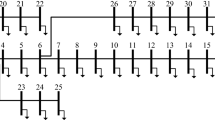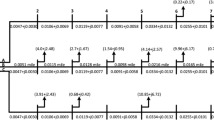Abstract
The presence of photovoltaic-based distributed generation in distribution networks brings a concern regarding intermittency of power generation. This concern can be mitigated through energy storage systems, incorporated into the network allowing instantaneous filling up of the gap between the generation and load demand. These energy storages are scheduled in such a way that they get charged during excess generation and discharged during the low generation periods. In this paper, a two-layer optimisation of the grid-connected active distribution network is performed in which the optimal location and sizes of the ‘solar generation and battery storage’ are optimised in the outer layer and accordingly the optimal battery scheduling considering the variations of solar radiation and load demand is performed in the inner layer. The optimisation is performed based on multiple objectives of energy loss reduction, voltage stability improvement and cost reduction of battery and local generation. The intermittency of the photovoltaic-based generation is considered using a probability-based 2m-Point Estimation Method. The above mentioned problem is solved using Honey Badger Optimisation due to its better exploration and exploitation ability to find better quality results. Moreover, this technique is not applied in the field of power system earlier. The proposed methodology has been applied on a radial network and has shown better voltage stability along with reduced energy losses, total costs of power purchase and total investments in solar based distributed generations and battery storage systems. Performance of the optimisation algorithm is also compared with few other well established optimisation algorithm.













Similar content being viewed by others
Data Availability
All the data used in this study are either presented in the tables or are taken from the references cited in this article.
References
Kyoto Protocol. United Nations Framework Convention on Climate Change. (2022) https://unfccc.int/kyoto_protocol. Accessed 17 Feb 2022.
UN Climate Change Summit, COP26. United Nations. (2022). https://www.un.org/en/climatechange/cop26. Accessed 17 Feb 2022.
India’s submission on pre-2020 actions. United Nations Framework Convention on Climate Change (2022). https://www4.unfccc.int/sites/SubmissionsStaging/Documents/201805010125---India%20on%20Pre-2020%20-%20Submission.pdf. Accessed 17 Feb 2022.
India’s non-fossil fuel based power generation target till 2030, Ministry of New and Renewable Energy. (n.d.). Solar Power: Current Status. Government of India (2022). https://mnre.gov.in/solar/current-status/. Accessed 17 Feb 2022.
International Solar Alliance (2022). https://isolaralliance.org/. Accessed 17 Feb 2022.
Singh B, Sharma J. A review on distributed generation planning. Renew Sustain Energy Rev. 2017;76:529–44.
Mehigan L, Deane JP, Gallachoir BPO, Bertsh V. A review of the role of distributed generation (DG) in future electricity systems. Energy. 2018;163:822–36.
Medina ACR, Franco JF, Rider MJ, Feltrin AP, Romero R. A mixed-integer linear programming approach for optimal type, size and allocation of distributed generation in radial distribution systems. Electr Power Syst Res. 2013;97:133–43.
Samala RK, Kotapuri MR. Optimal allocation of distributed generations using hybrid technique with fuzzy logic controller radial distribution system. SN Appl Sci. 2020. https://doi.org/10.1007/s42452-020-1957-3.
El-Ela AAA, Allam SM, Shaheen AM, Nagem NA. Optimal allocation of biomass distributed generation in distribution systems using equilibrium algorithm. Int Trans Elect Energy Syst. 2021. https://doi.org/10.1002/2050-7038.12727.
Pereira LDL, Yahyaoui I, Fiorotti R, Menezes LSD, Fardin JF, Rocha HRO, Tadeo F. Optimal allocation of distributed generation and capacitor banks using probabilistic generation models with correlations. Appl Energy. 2022. https://doi.org/10.1016/j.apenergy.2021.118097.
Bawazir RO, Cetin NS. Comprehensive overview of optimizing PV-DG allocation in power system and solar energy resource potential assessments. Energy Rep. 2020;6:173–208.
Soroudi A, Aien M, Ehsan M. A probabilistic modeling of photo voltaic modules and wind power generation impact on distribution networks. IEEE Syst J. 2012;6(2):254–9.
Hung DQ, Mithulananthan N, Bansal RC. Integration of PV and BES units in commercial distribution systems considering energy loss and voltage stability. Appl Energy. 2014;113:1162–70.
Ghatak SR, Sannigrahi S, Acharjee P. Optimised planning of distribution network with photovoltaic system, battery storage, and DSTATCOM. IET Renew Power Gener. 2018;12(15):1823–32.
Hannan MA, Wali SB, Ker PJ, Rahman MSA, Mansor M, Ramachandaramurthy VK, Muttaqi KM, Mahlia TMI, Dong ZY. Battery energy-storage system: a review of technologies, optimization objectives, constraints, approaches, and outstanding issues. J Energy Storage. 2021. https://doi.org/10.1016/j.est.2021.103023.
Paliwal NK, Singh AK, Singh NK. A day-ahead optimal energy scheduling in a remote microgrid along with battery storage system via global best guided ABC algorithm. J Energy Storage. 2019. https://doi.org/10.1016/j.est.2019.100877.
Luo L, Abdulkareem SS, Rezvani A, Miveh MR, Samad S, Aljojo N, Pazhoohesh M. Optimal scheduling of a renewable based microgrid considering photovoltaic system and battery energy storage under uncertainty. J Energy Storage. 2020. https://doi.org/10.1016/j.est.2020.101306.
Sedighizadeh M, Esmaili M, Jamshidi A, Ghaderi MH. Stochastic multi-objective economic-environmental energy and reserve scheduling of microgrids considering battery energy storage system. Electr Power Energy Syst. 2019;106:1–16.
Lee JO, Kim YS. Novel battery degradation cost formulation for optimal scheduling of battery energy storage systems. Int J Electr Power Energy Syst. 2022. https://doi.org/10.1016/j.ijepes.2021.107795.
Hassan A, Al-Abdeli YM, Masek M, Bass O. Optimal sizing and energy scheduling of grid-supplemented solar PV systems with battery storage: sensitivity of reliability and financial constraints. Energy. 2022. https://doi.org/10.1016/j.energy.2021.121780.
Bhoi SK, Nayak MR. Optimal scheduling of battery storage with grid tied PV systems for trade-off between consumer energy cost and storage health. Microprocess Microsyst. 2020. https://doi.org/10.1016/j.micpro.2020.103274.
Zeinalzadeh A, Mohammadi Y, Moradi MH. Optimal multi objective placement and sizing of multiple DGs and shunt capacitor banks simultaneously considering load uncertainty via MOPSO approach. Electr Power Energy Res. 2015;67:336–49.
Abdi S, Afshar K. Application of IPSO-Monte-Carlo for optimal distributed generation allocation and sizing. Electr Power Energy Syst. 2013;44:786–97.
Hong HP. An efficient point estimate method for probabilistic analysis. Reliab Eng Syst Saf. 1998;59:261–7.
Sharma S, Bhattacharjee S, Bhattacharya A. Probabilistic operation cost minimisation of microgrid. Energy. 2018;148:1116–39.
Das D, Bhattacharya A, Ray RN. Dragonfly algorithm for solving probabilistic economic load dispatch problems. Neural Comput Appl. 2020;32:3029–45.
Rawat MS, Vadhera S. Probabilistic approach to determine penetration of hybrid renewable DGs in distribution network based on voltage stability index. Electr Eng. 2020;45:1473–98.
Prakash P, Meena DC, Malik H, Alotaibi MA, Khan IA. A novel hybrid approach for optimal placement of non-dispatchable distributed generations in radial distribution system. Mathematics. 2021. https://doi.org/10.3390/math9243171.
Hashim FA, Houssein EH, Hussain K, Mabrouk MS, Al-Atabany W. Honey badger algorithm: new metaheuristic algorithm for solving optimization problems. Math Comput Simul. 2022;192:84–110.
Das SK, Sarkar S (2019) Optimisation of location, size and power factor of DG based on a new voltage stability index. In: 2019 IEEE 16th India council international conference (INDICON), Rajkot, India, p 1–4. doi: https://doi.org/10.1109/INDICON47234.2019.9029013
Pal A, Bhattacharya A, Chakraborty AK. Placement of public fast-charging station and solar distributed generation with battery energy storage in distribution network considering uncertainties and traffic congestion. J Energy Storage. 2021. https://doi.org/10.1016/j.est.2021.102939.
Mondal S, Bhattacharya A, Dey SH. Multi-objective economic emission load dispatch solution using gravitational search algorithm and considering wind power penetration. Electr Power Energy Syst. 2013;44:282–92.
Pvwatts calculator. National renewable energy laboratory (2022). https://pvwatts.nrel.gov/pvwatts.php. Accessed 22 Feb 2022.
Author information
Authors and Affiliations
Corresponding author
Ethics declarations
Conflict of interest
The authors declare that they have no conflict of interest.
Additional information
Publisher's Note
Springer Nature remains neutral with regard to jurisdictional claims in published maps and institutional affiliations.
This article is part of the topical collection “Enabling Innovative Computational Intelligence Technologies for IOT” guest edited by Omer Rana, Rajiv Misra, Alexander Pfeiffer, Luigi Troiano and Nishtha Kesswani.
Rights and permissions
Springer Nature or its licensor (e.g. a society or other partner) holds exclusive rights to this article under a publishing agreement with the author(s) or other rightsholder(s); author self-archiving of the accepted manuscript version of this article is solely governed by the terms of such publishing agreement and applicable law.
About this article
Cite this article
Das, S.K., Sarkar, S. & Bhattacharya, A. Optimal Allocation of PV-Based Distributed Generations and Scheduling of Battery Storage in Grid-Connected Micro-grid Using Bi-level Optimisation. SN COMPUT. SCI. 4, 588 (2023). https://doi.org/10.1007/s42979-023-02003-9
Received:
Accepted:
Published:
DOI: https://doi.org/10.1007/s42979-023-02003-9




